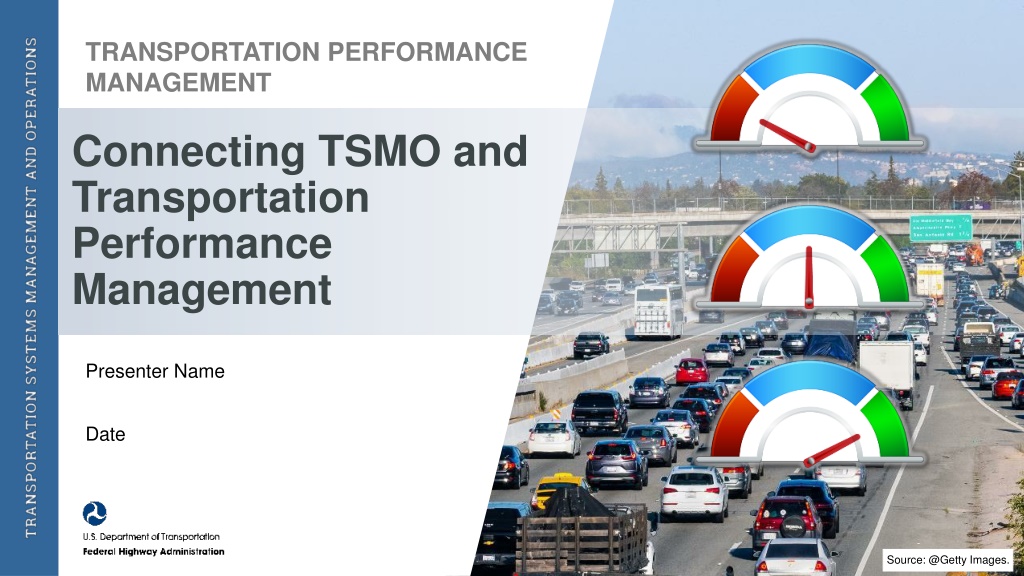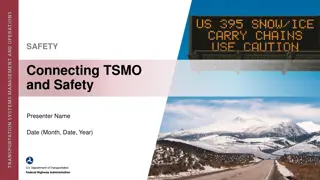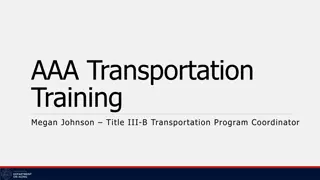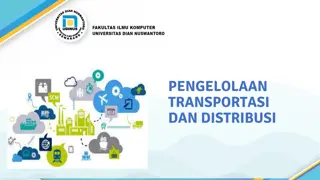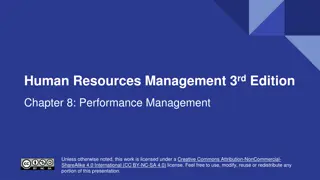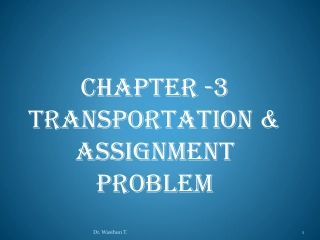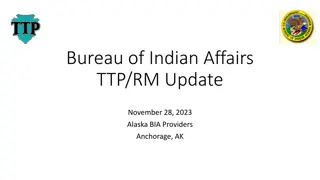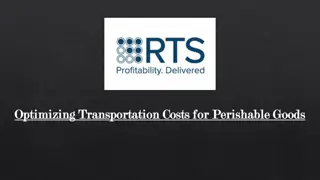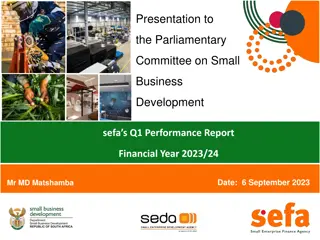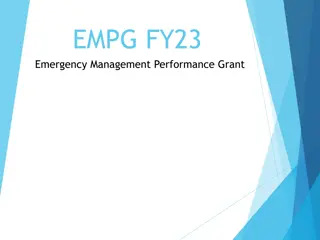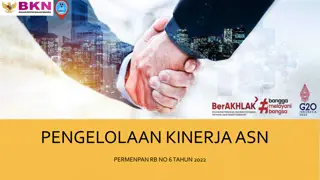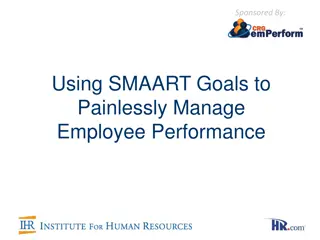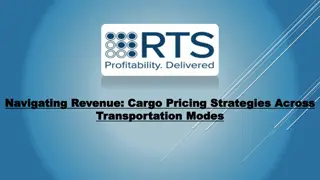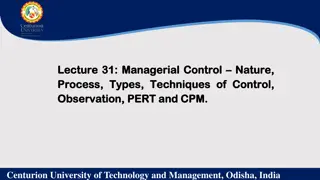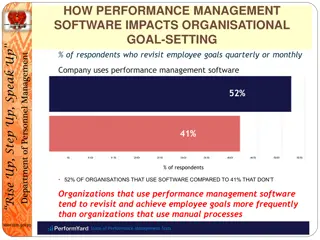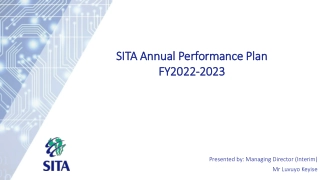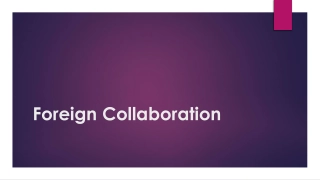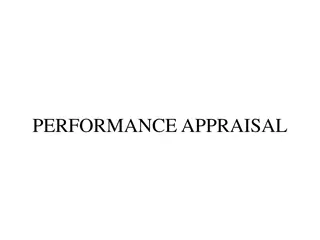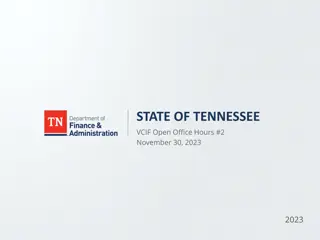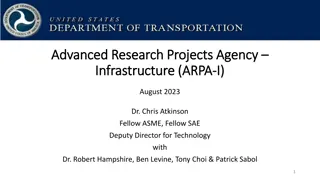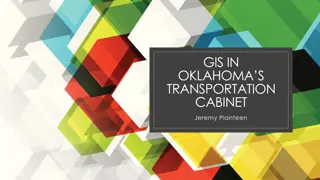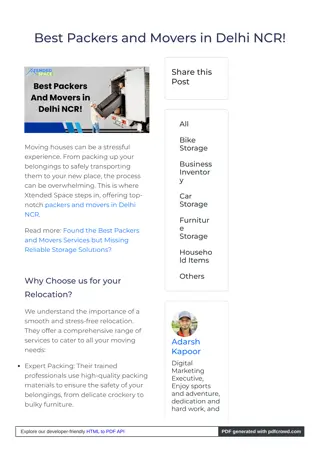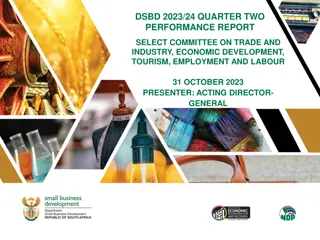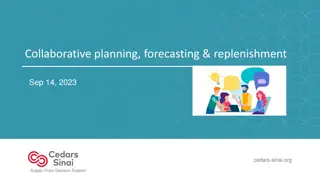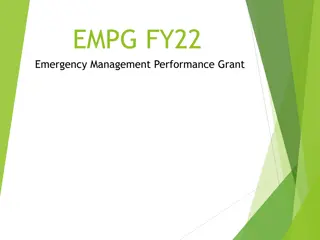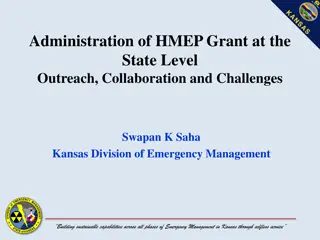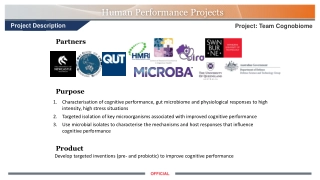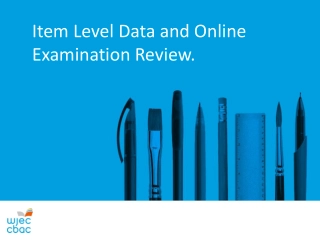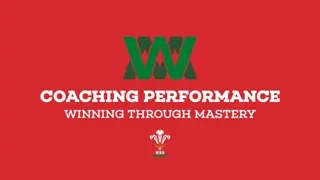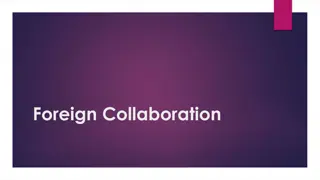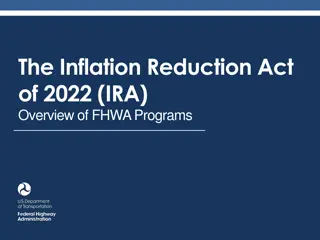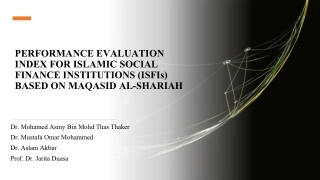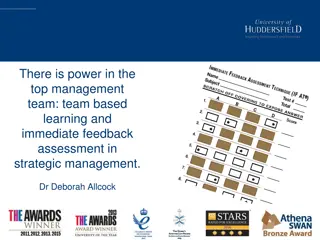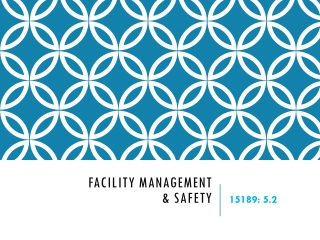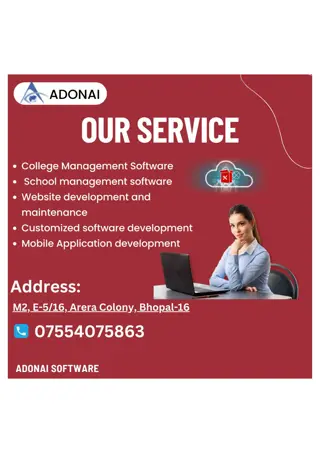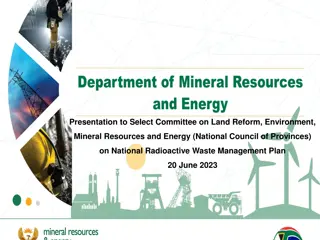Enhancing Transportation Performance Management through TSMO Collaboration
Advancements in technology and evolving customer needs are driving changes in transportation management. Transportation Systems Management and Operations (TSMO) offers strategies to optimize operational performance, complementing traditional capacity projects. Collaboration between TSMO and Transportation Performance Management (TPM) is crucial to enhancing system performance through efficient resource utilization, data-driven planning, goal setting, performance tracking, and effective communication.
Enhancing Transportation Performance Management through TSMO Collaboration
PowerPoint presentation about 'Enhancing Transportation Performance Management through TSMO Collaboration'. This presentation describes the topic on Advancements in technology and evolving customer needs are driving changes in transportation management. Transportation Systems Management and Operations (TSMO) offers strategies to optimize operational performance, complementing traditional capacity projects. Collaboration between TSMO and Transportation Performance Management (TPM) is crucial to enhancing system performance through efficient resource utilization, data-driven planning, goal setting, performance tracking, and effective communication.. Download this presentation absolutely free.
Presentation Transcript
TRANSPORTATION PERFORMANCE MANAGEMENT Connecting TSMO and Transportation Performance Management Presenter Name Date Source: @Getty Images. Source: @Getty Images
Disclaimer The U.S. Government does not endorse products or manufacturers. Trademarks or manufacturers names appear in this presentation only because they are considered essential to the objective of the presentation. They are included for informational purposes only and are not intended to reflect a preference, approval, or endorsement of any one product or entity. 2
Transportation Landscape Is Changing Advances in technology, data, computing power, and analytics Customer needs and expectations Limited funds and tighter budgets Performance measures, target setting, and monitoring requirements Source: Getty Images. 4
What Is Transportation Systems Management and Operations (TSMO)? Offers an integrated set of strategies to optimize operational performance of the existing transportation system Approaches performance from a systems perspective that spans corridors, facilities, jurisdictions, modes, and agencies Helps agencies balance supply and demand on the system and provide flexible solutions to manage dynamic conditions Can complement capacity projects, or in some cases can provide lower cost, faster alternatives 5
Increased Need To Collaborate TSMO and transportation performance management (TPM) share common goals that can be better achieved through collaboration. TSMO and TPM programs seek to: Enhance system performance with strategic use of resources Leverage data to plan and operate smarter Establish measurable objectives for improving performance Track performance and align investments Communicate improvements and demonstrate an effective use of taxpayer resources 6
How TSMO Supports TPM TSMO strategies can provide cost-effective solutions to quickly improve performance and support national performance measures such as reliability and safety. TSMO technologies provide a rich source of data for understanding, assessing, and monitoring performance of the transportation system in realtime. TSMO provides levers (e.g., signal timing, hard-shoulder running) that enable agencies to actively manage the system in real time to improve performance. TSMO reinforces the same objectives-driven, performance-based approach to improve and predict transportation system performance TPM uses. 7
TSMO Can Help Agencies Move the Needle on National Performance Measures TSMO supports improvements along the National Performance Measures for System Performance: Percent of person-miles traveled on the interstate that are reliable Percent of person-miles traveled on the noninterstate National Highway System that are reliable Truck Travel Time Reliability (TTTR) Index Annual hours for peak hour excessive delay per capita Percent of nonsingle-occupancy vehicle travel Total emissions reduction TSMO can also positively impact National Performance Measures for Safety. 8
How TPM Supports TSMO TPM offers an overarching framework to manage operational performance of the transportation system. Data and analytics used in TPM can help agencies evaluate and select TSMO strategies to meet internal and external objectives. Measuring and reporting on quantitative impacts of TSMO strategies can provide the business case for additional funding for TSMO. TPM helps identify issues in operational performance. 9
Opportunities for TSMO and TPM Collaboration Setting performance targets for operations-related performance measures Developing TSMO program plans or strategic plans Others? Making the business case for TSMO Managing TSMO assets Creating project prioritization methods Sharing data 10
Next Steps Bring TSMO and TPM leaders together within your agency to identify areas of common interest and mutual objectives Determine if/how TSMO strategies are supporting agency TPM goals Discuss where TSMO can make an even greater impact on TPM goals Identify TSMO and TPM data sources and opportunities to share data 11
Goals of This Presentation Increase awareness of transportation systems management and operations (TSMO) strategies and goals Demonstrate alignment between TSMO and transportation performance management (TPM) Describe potential benefits of TSMO and TPM collaboration Identify opportunities for TSMO and TPM to collaborate Highlight examples of TSMO and TPM connections Discuss challenges and how to overcome them Present next steps 13
Presentation Overview What is TSMO? What is TPM? Why Connect TSMO and TPM? Opportunities for Collaboration Examples of Collaboration Between TSMO and TPM Overcoming Challenges to Collaboration Next Steps for Connecting TSMO and TPM 14
Definition of TSMO Integrated [set of] strategies to optimize the performance of existing infrastructure through the implementation of multimodal and intermodal, cross-jurisdictional systems, services, and projects designed to preserve capacity and improve security, safety, and reliability of the transportation system.*,** *Title 23 of the U.S. Code (USC) 101 (a)(30)(A) Definitions and Declarations of Policy,2011 **Federal Highway Administration (FHWA) website: https://ops.fhwa.dot.gov/tsmo/ 16
Characteristics of TSMO Offers an integrated set of strategies to optimize operational performance of the existing transportation system Approaches performance from a systems perspective that spans corridors, facilities, jurisdictions, modes, and agencies Helps agencies balance supply and demand on the system and provide flexible solutions to manage dynamic conditions Can complement capacity projects, or in some cases can provide lower cost, faster alternatives 17
Examples of TSMO Strategies Source: Federal Highway Administration 18
Incident/Event Management Strategies Source: Federal Highway Administration. 19
Traffic Management Strategies Source: Federal Highway Administration. 20
Demand Management Strategies Source: Federal Highway Administration. 21
TSMO Is a Way of Thinking That Supports State Departments of Transportation (DOTs) Missions We provide safe, reliable and cost-effective transportation options to improve communities and economic vitality for people and businesses. Washington State DOT (WSDOT) mission1 To provide the best multimodal transportation system for Colorado that most effectively and safely moves people, goods, and information. Colorado DOT mission2 1 WSDOT, Strategic Plan, https://www.wsdot.wa.gov/about/secretary/strategic-plan/ 2 Colorado DOT, Mission, Vision & Values, https://www.codot.gov/about/mission-and-vision.html 22
TSMO Supports Many State and Local DOT Goals Reduced congestion Smoother and more reliable traffic flow Improved safety Cleaner air and less wasted fuel More efficient use of resources and existing facilities Increased economic vitality Improved quality of life 23
Example TSMO Strategies That Support Transportation Agency Goals TSMO Strategies Goals Traffic signal coordination, congestion pricing, demand management Manage nonrecurring events (incidents, weather), managed lanes, traveler information Utilize the full system coordinate all modes, transit signal priority Reduced congestion Smoother and more reliable traffic flow More efficient use of resources and existing facilities 24
TSMO State of the Practice Application of TSMO has accelerated in agencies across the country over the past 5 10 years Recognition of TSMO s value has grown, leading to a variety of approaches for advancing TSMO in agencies. For example: Establishing a TSMO division or office Formalizing a TSMO program Integrating TSMO throughout the agency Establishing a TSMO committee Identifying TSMO champions or liaisons Conducting a TSMO capability maturity model (CMM) self-assessment Developing a TSMO program plan 25
Resources on TSMO What Is TSMO? (frequently asked questions) https://ops.fhwa.dot.gov/tsmo Organizing and Planning for Operations web page https://ops.fhwa.dot.gov/plan4ops Communicating TSMO web page https://ops.fhwa.dot.gov/plan4ops/focus_areas/communic ating_tsmo.htm National Operations Center of Excellence (NOCoE) website https://www.transportationops.org/ Enhancing Transportation: Connecting TSMO and Performance Management, https://ops.fhwa.dot.gov/publications/fhwahop18095 26
TPM Overview Overarching framework for performance management a strategic approach that uses system information to make investment and policy decisions to achieve national performance goals Regular, ongoing process that is systematically applied Source: FHWA, What Is TPM? , https://www.fhwa.dot.gov/tpm/about/tpm.cfm 28
Why TPM Is Important Provides key information to help decisionmakers understand consequences of investment decisions across transportation assets or modes Improves communications among decisionmakers, stakeholders, and the traveling public Ensures targets and measures are developed in cooperative partnerships and based on data and objective information Source: FHWA, What Is TPM? , https://www.fhwa.dot.gov/tpm/about/tpm.cfm 29
TPMNational Performance Goals Safety Infrastructure condition Congestion reduction System reliability Freight movement and economic vitality Environmental sustainability Reduced project delivery delays Sources: 23 USC 150(b) National Goals and Performance Management Measurements, 2016 https://www.fhwa.dot.gov/tpm/about/regulations.cfm 30
The Transportation Landscape Is Changing Advances in technology, data, computing power, and analytics Customer needs and expectations Limited funds and tighter budgets Performance measures, target setting, and monitoring requirements Source: Getty Images. 32
An Increased Need To Collaborate TSMO and TPM share common goals that can be better achieved through collaboration. TSMO and TPM programs seek to: Enhance system performance with strategic use of resources Leverage data to plan and operate smarter Establish measurable objectives for improving performance Track performance and align investments Communicate improvements and promote effective use of taxpayer resources 33
Mutual Benefits of Collaboration Coordinating TSMO and TPM efforts enables shared goals to be achieved more efficiently. Example TSMO Goals: Reduce congestion and improve reliability Leverage all modes to improve mobility Get more out of existing infrastructure Use data for decisionmaking Example TPM Goals: Meet delay and reliability performance targets Reduce total emissions Maximize use of resources Use performance-based data for decisions 34
How TSMO Can Support TPM TSMO strategies can provide cost-effective solutions to quickly improve performance and support national performance measures such as reliability and safety. TSMO technologies provide a rich source of data for understanding, assessing, and monitoring performance of the transportation system in realtime. TSMO provides levers (e.g., signal timing, hard-shoulder running) that enable agencies to actively manage the system in realtime to improve performance. TSMO reinforces the same objectives-driven, performance-based approach to improving and predicting transportation system performance used by TPM. 35
TSMO Can Help Agencies Move the Needle on the National Performance Measures TSMO supports improvements along the national performance measures for system performance: Percent of person-miles traveled on the interstate that are reliable Percent of person-miles traveled on the noninterstate NHS that are reliable Truck Travel Time Reliability (TTTR) Index Annual hours for peak hour excessive delay per capita Percent of nonsingle occupancy vehicle travel Total emissions reduction TSMO can also positively impact national performance measures for safety. 36
How TPM Can Support TSMO TPM offers an overarching framework to manage operational performance of the transportation system. Data and analytics used in TPM can help evaluate and select TSMO strategies to meet internal and external objectives. Measuring and reporting on quantitative impacts of TSMO strategies can provide the business case for additional funding for TSMO. TPM can identify issues in operational performance. 37
Opportunities for Collaboration Between TSMO and TPM Setting performance targets for operations-related performance measures Developing TSMO program plans or strategic plans Others? Making the business case for TSMO Managing TSMO assets Creating project prioritization methods Sharing data 39
Setting Performance Targets Agency staff can combine expertise to identify realistic performance targets. Targets should be based on historical data, likely future conditions, and impacts of future TSMO investments. TPM staff can offer data, analysis, and information on broader trends. TSMO staff can provide input on setting targets for federally required performance measures in areas of system performance. Source: Getty Images. 40
Developing TSMO Plans TSMO strategic and program plans often contain goals, objectives, performance measures, and targets to provide direction for the TSMO effort. Collaboration with TPM during development of these plans is important for: Gathering necessary data Understanding baseline conditions Helping ensure TSMO efforts support agency TPM goals 41
Managing TSMO Assets TPM can offer a performance management framework to support lifecycle planning for TSMO assets and maximize their useful life. TSMO strategies often require equipment, technology, and communications systems. The service life of TSMO assets varies. Maintenance, replacement, and upgrade costs need to be planned. Source: Getty Images. 42
Sharing Data Among TSMO and TPM Programs TPM staff work with a variety of datasets that may be helpful for TSMO programs. TSMO and TPM programs may exchange staff expertise in National Performance Management Research Data Set (NPMRDS) and vehicle probe data for speed and travel time performance measures. TSMO programs generate a large amount of system performance data helpful for TPM, such as incident, weather, crowdsourced travel time/incident reporting, work zone, special event, video, computer-aided dispatch (CAD), volume, and speed data. Source: Getty Images. 43
Creating Project Prioritization Methods Agencies are beginning to develop performance-based methods for TSMO project prioritization. The methods are typically based on system performance measures, cost- benefit analyses, and anticipated outcomes Data-driven investment decisionmaking is an essential part of the TPM framework. TPM staff can advise on available data, performance measures, and creating a quantitative prioritization system. Source: Federal Highway Administration. 44
Making the Business Case for TSMO Collaborate to tell the agency s story about the value of TSMO Use performance measures and data to communicate the return on investment and business case for investing in TSMO Source: Getty Images. 45
Examples of Collaboration Between TSMO and TPM
WSDOT: Connecting TPM and TSMO (1/2) Performance management and TSMO are intrinsically linked. All DOT functions that use data-based decisionmaking to maximize investments are linked to TPM. Daniela Bremmer, Cooperative Automated Transportation Development WSDOT WSDOT s performance management program unit aims to create comprehensive and streamlined performance management efforts that inform decisionmaking at all levels of the DOT. 47
WSDOT: Connecting TPM and TSMO (2/2) TPM for operational strategies has been part of TSMO for nearly two decades. TSMO has already benefited from connecting TSMO and TPM at WSDOT at many different levels: For example, after reporting regularly on incident response (IR) program performance results, the legislature significantly increased IR funding. Assistant Director of Performance Management serves on WSDOT s new cross-disciplinary TSMO Steering Committee that developed its TSMO program plan. WSDOT is working to include more TPM action items within its new TSMO plan: Develop a specific TSMO performance management plan. Develop and deploy TSMO performance management system. 48
North Carolina DOT: Linking TSMO and TPM (1/2) The TSMO unit works with the North Carolina DOT (NCDOT) central performance office to: Decide what performance measures the TSMO unit should report Set up the data feeds necessary for the TSMO unit to calculate the measures The TSMO unit measures a few key indicators for internal reports and public-facing dashboards: Incident clearance time Peak period speeds in urban areas Related measures required by Moving Ahead for Progress in the 21st Century Act (MAP-21) (Public Law 112-141, 2012). 49
NCDOT: Linking TSMO and TPM (2/2) Agency-wide performance management processes originated from a 2007 2009 NCDOT effort to transform agency processes At NCDOT, TPM and TSMO have common goals of improving safety and decreasing delay. The TSMO unit is looking to better tie outcome measures to TSMO resource allocation. Challenges include isolating the contribution of TSMO and outcome-based measures 50
